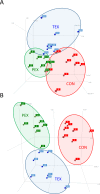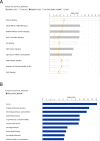Proteomic investigation of human skeletal muscle before and after 70 days of head down bed rest with or without exercise and testosterone countermeasures
- PMID: 31194764
- PMCID: PMC6563988
- DOI: 10.1371/journal.pone.0217690
Proteomic investigation of human skeletal muscle before and after 70 days of head down bed rest with or without exercise and testosterone countermeasures
Abstract
Introduction: Long-term head-down bed rest (HDBR) results in musculoskeletal losses similar to those observed during long-term space flight. Agents such as testosterone, in addition to regular exercise, are effective countermeasures for reducing loss of skeletal muscle mass and function.
Objective: We investigated the skeletal muscle proteome of healthy men in response to long term HDBR alone (CON) and to HDBR with exercise (PEX) or exercise plus testosterone (TEX) countermeasures.
Method: Biopsies were performed on the vastus lateralis before (pre) HDBR and on HDBR days 32 (mid) and 64 (post). Extracted proteins from these skeletal muscle biopsies were subjected to 2-dimensional gel electrophoresis (2DE), stained for phosphoproteins (Pro-Q Diamond dye) and total proteins (Sypro Ruby dye). Proteins showing significant fold differences (t-test p ≤ 0.05) in abundance or phosphorylation state at mid or post were identified by mass spectroscopy (MS).
Results: From a total of 932 protein spots, 130 spots were identified as potentially altered in terms of total protein or phosphoprotein levels due to HDBR and/or countermeasures, and 59 unique molecules emerged from MS analysis. Top canonical pathways identified through IPA included calcium signaling, actin cytoskeleton signaling, integrin linked kinase (ILK) signaling, and epithelial adherens junction signaling. Data from the pre-HDBR proteome supported the potential for predicting physiological post-HDBR responses such as the individual's potential for loss vs. maintenance of muscle mass and strength.
Conclusions: HDBR resulted in alterations to skeletal muscle abundances and phosphorylation of several structural and metabolic proteins. Inclusion of exercise alone or in combination with testosterone treatment modulated the proteomic responses towards cellular reorganization and hypertrophy, respectively. Finally, the baseline proteome may aid in the development of personalized countermeasures to mitigate health risks in astronauts as related to loss of muscle mass and function.
Trial registration: ClinicalTrials.gov NCT00891449.
Conflict of interest statement
The authors have declared that no competing interests exist.
Figures




Similar articles
-
Efficacy of Testosterone plus NASA Exercise Countermeasures during Head-Down Bed Rest.Med Sci Sports Exerc. 2018 Sep;50(9):1929-1939. doi: 10.1249/MSS.0000000000001616. Med Sci Sports Exerc. 2018. PMID: 29924745 Free PMC article. Clinical Trial.
-
The effect of rowing ergometry and resistive exercise on skeletal muscle structure and function during bed rest.J Appl Physiol (1985). 2014 Jun 15;116(12):1569-81. doi: 10.1152/japplphysiol.00803.2013. Epub 2014 May 1. J Appl Physiol (1985). 2014. PMID: 24790012 Clinical Trial.
-
Effects of exercise countermeasure on myocardial contractility measured by 4D speckle tracking during a 21-day head-down bed rest.Eur J Appl Physiol. 2019 Dec;119(11-12):2477-2486. doi: 10.1007/s00421-019-04228-0. Epub 2019 Sep 17. Eur J Appl Physiol. 2019. PMID: 31531733
-
A review of muscle atrophy in microgravity and during prolonged bed rest.J Br Interplanet Soc. 1993 Mar;46(3):83-6. J Br Interplanet Soc. 1993. PMID: 11539498 Review.
-
Long-duration bed rest as an analog to microgravity.J Appl Physiol (1985). 2016 Apr 15;120(8):891-903. doi: 10.1152/japplphysiol.00935.2015. Epub 2016 Feb 18. J Appl Physiol (1985). 2016. PMID: 26893033 Review.
Cited by
-
Omics Studies of Specialized Cells and Stem Cells under Microgravity Conditions.Int J Mol Sci. 2024 Sep 17;25(18):10014. doi: 10.3390/ijms251810014. Int J Mol Sci. 2024. PMID: 39337501 Free PMC article. Review.
-
Effects of Various Muscle Disuse States and Countermeasures on Muscle Molecular Signaling.Int J Mol Sci. 2021 Dec 31;23(1):468. doi: 10.3390/ijms23010468. Int J Mol Sci. 2021. PMID: 35008893 Free PMC article. Review.
-
Disuse-Induced Muscle Fatigue: Facts and Assumptions.Int J Mol Sci. 2024 May 3;25(9):4984. doi: 10.3390/ijms25094984. Int J Mol Sci. 2024. PMID: 38732203 Free PMC article. Review.
-
Exercise and Testosterone Countermeasures to Mitigate Metabolic Changes during Bed Rest.Life Sci Space Res (Amst). 2020 Aug;26:97-104. doi: 10.1016/j.lssr.2020.03.008. Epub 2020 May 20. Life Sci Space Res (Amst). 2020. PMID: 32718692 Free PMC article.
-
Signatures of muscle disuse in spaceflight and bed rest revealed by single muscle fiber proteomics.PNAS Nexus. 2022 Jun 11;1(3):pgac086. doi: 10.1093/pnasnexus/pgac086. eCollection 2022 Jul. PNAS Nexus. 2022. PMID: 36741463 Free PMC article.
References
Publication types
MeSH terms
Substances
Associated data
Grants and funding
LinkOut - more resources
Full Text Sources
Medical

